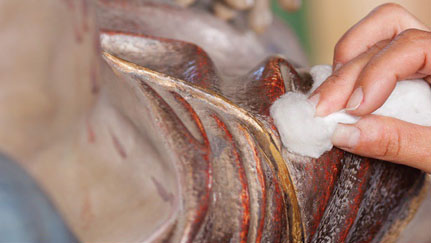Loading...
Artwork care and maintenance

Whether you are lifelong art collector, a passionate home decorator or recently purchased your first piece, your art collection is a representation of you, and we are committed to helping you properly care for it.
Like any investment, artwork requires careful maintenance to preserve its longevity and value. A Private Client Collections Policy is a crucial first step in protecting your art.
Routine care helps avoid damage and corrosion. When staging your artwork, be sure to consider these common home dangers:
- Direct sunlight
- Extreme and/or rapid temperature changes
- Foot traffic
- Heat
- Smoke
- Proximity to doors and windows
- Water damage
For deep cleanings or restorations, your Private Client Risk Solutions advisor can provide you a list of professional conservators. For routine maintenance, we suggest the following techniques:
- Paintings: Moisture is an enemy to oils and acrylics on canvas and can also harm delicate frames and the canvas itself. For routine cleaning, a simple feather duster will suffice when gently brushed over image and frame. Never use a chemical process cleaning product. Artwork on canvas should always be cleaned by professional conservators. The most widely respected conversation group is The American Institute of Conservation (AIC).
- Frames: Cleaning a frame can be a difficult procedure. When polishing wood frames, we recommend using only organic oils or wax. Be careful not to get oils or wax on the artwork surface. This could end up requiring professional cleaning to remove it. Note the frame treatment of your print before cleaning. Test the looseness of your frame. Gently squeeze a corner of the glazing and the back edge of the frame with your thumb and index finger. If the glazing moves and creates a space, then the frame must be cleaned carefully.
- Prints: Most often, prints are covered with an acrylic or glass glazing. When cleaning the glazing, we recommend a simple mild cleaning solution and warm water. Be careful to lightly dampen the cleaning cloth so the solution does not seep inside the frame and ruin the image, matting or paper.
- Acrylic, fabric and wood art: Porous materials, such as acrylic, fabric and wood, art will absorb any liquid used to clean them. For these types of art we recommend using a soft feather duster for routine cleaning.
- Bronze sculptures: As a general rule, we recommend cleaning bronze statues only with mild soap and a lightly damp cloth. Over time, bronze statues develop patina - a natural process that artists are likely to take into account when creating the statue. Smoke can also create a film on bronze statues; the mild solution should help remove it.